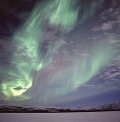
|
back to spaceweather.com |

|
|
Summary: A coronal mass ejection (CME) swept past Earth at 0450 UT on April 23rd. The impact, which was well-timed for aurora watchers in North America, triggered a 3-to-5 hour long G2-class geomagnetic storm. The CME (movie) that struck Earth left the Sun on April 21st -- hurled into space by a powerful X1-class explosion near sunspot 9906. The blast was not squarely Earth-directed. As a result, the CME delivered only a glancing blow to our planet's magnetosphere. |
| Photographer, Location | Images | Comments | |
 |
Calvin Hall,
the Kenai Peninsula, Alaska, USA April 23 |
#1, #2 | C. Hall: "I had high hopes for this night, so I snowmobiled up onto a glacier on the north edge of the Kenai Peninsula and set up a tent to spend the night. The auroras started early, before it got dark but never amounted to much. As I crawled into the tent at 3:00 am a hanging glacier calved, which sounded like the rumble of a jet. It seems there is always something to make aurora chasing exciting. " |
 |
Yuichi Takasaka,
Whitehorse, Yukon, Canada April 23 |
#1, #2 | Photo details: KX, 20mm SMC, f2.8, 20 to 30 seconds, Fuji Provia 400F |
 |
Jody Majko,
Winnipeg, Manitoba, Canada April 23 |
#1, #2, #3, #4, #5 | J. Majko: "The entire sky lit up with these ghostly looking auroras...best display I've seen since November. They were so active, it looked like ten billion angels dancing in the heavens." Photo details: Canon EOS 50mm lens/Kodak Film, 10 second exposure/4.0 aperture |
 |
Scott McGee,
near Anchorage, Alaska, USA April 23 |
#1 | S. McGee: "This view of the northern lights looks to the west back toward Anchorage. The Kenai Peninsula and Kenai Mountains are on the left, and the Chughach Mountains are on the right side of Turnagain Arm. In addition to the northern lights, the planets Mercury, Venus, Mars, Jupiter, and Saturn are visible. A larger version of this photo is posted here." |
 |
Carol Lakomiak,
Tomahawk, Wisconsin, USA April 23 |
#1 | C. Lakomiak: "This moonlit auroral display during the wee hours of April 23rd was quite bright and fast moving. Comet Ikeya-Zhang's tail was bleached out by moonlight and auroras, but you can still see the coma. It's between Alpha Cephei and Mu Cephei (Herschel's *Garnet Star*)." |
 |
Dominic
Cantin, 175 km north of Quebec City, Canada April 23 |
#1, #2, #3, #4, #5, #6, #7 | Photo Details : 28 mm @ f 2.8 , 25 sec , Fuji Superia 800. |
 |
Paul Wicklund,
Peone Prairie, north of Spokane, Washington, USA April 23 |
#1, #2, #3, more | Photo details: Minlota X-700, Kodak 400 Max, 15 to 20 second exposures. |
 |
Ken
Cravillion, near Auroraville, Wisconsin, USA April 23 |
#1, #2, #3, #4, #5, #6, #7, #8, more | It's clear why this spot in Wisconsin was named Auroraville. |